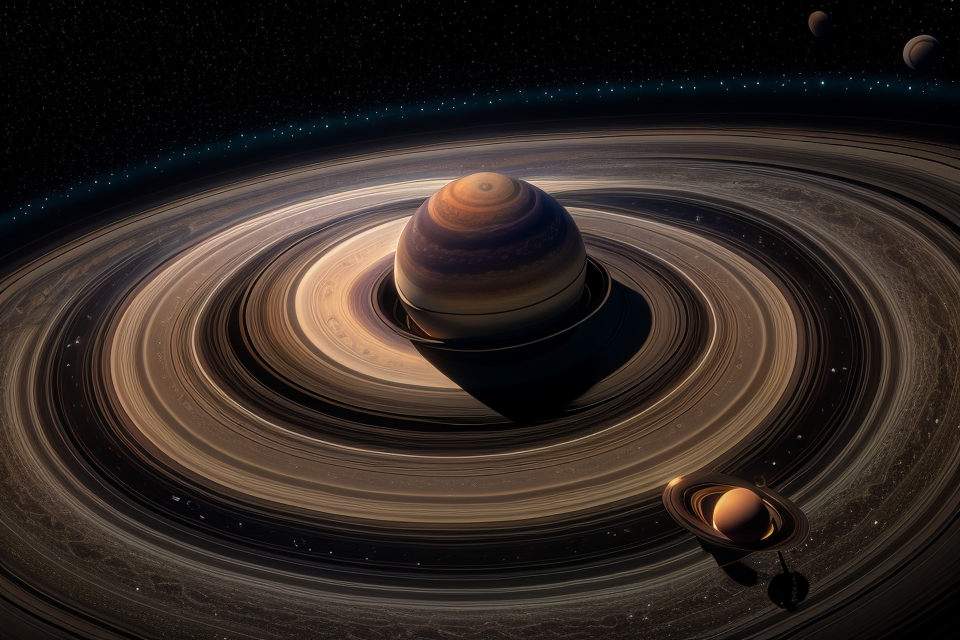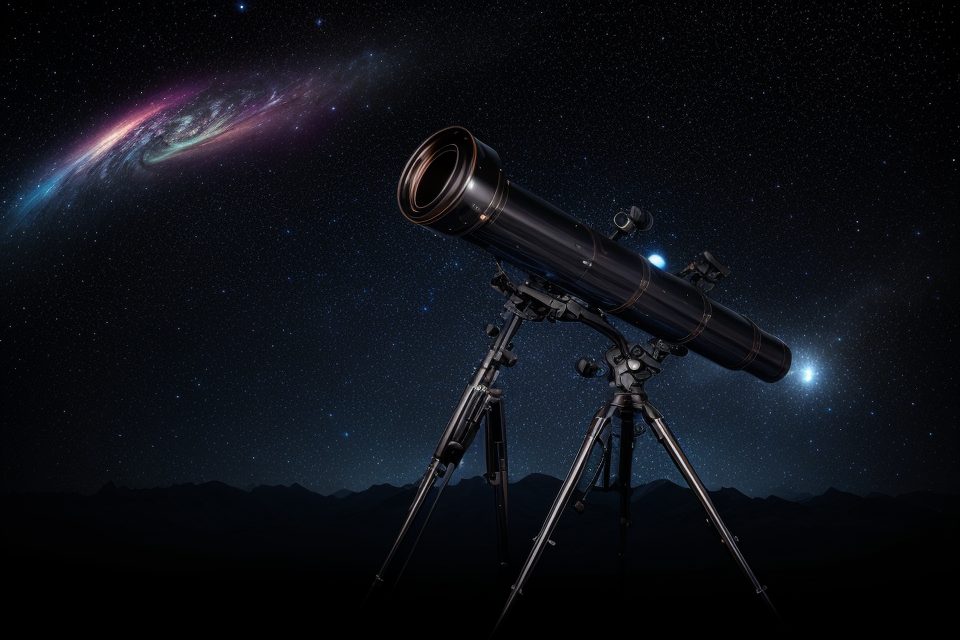Saturn, the sixth planet from the sun, is one of the most captivating celestial bodies in our solar system. Its iconic rings, which are comprised of countless ice and rock particles, have intrigued astronomers and stargazers for centuries. However, in order to get a clear view of these breathtaking rings, it’s essential to have the right telescope. In this guide, we’ll explore the best telescopes for viewing Saturn’s rings and unveil the mysteries of this fascinating planet. Whether you’re a seasoned astronomer or a beginner, this guide will help you choose the perfect telescope for your observation. So, let’s get started on our journey to explore the wonders of Saturn!
Understanding Saturn’s Rings
What are Saturn’s Rings?
Saturn’s rings are a spectacular natural phenomenon that have fascinated astronomers and stargazers alike for centuries. The rings are a massive, flat structure composed of countless small ice particles that orbit around the planet Saturn. They are thought to be the remains of a comet or an asteroid that was torn apart by Saturn’s gravitational pull, creating a debris field that eventually coalesced into the beautiful ring system we see today.
The rings of Saturn are incredibly thin, with a thickness ranging from only a few kilometers to several tens of kilometers at their maximum. Despite their relatively small size, they stretch outwards from the planet for over 175,000 kilometers, making them one of the most extended objects in the solar system. The rings are also incredibly bright, reflecting sunlight back towards Earth, and they can be easily observed with even small telescopes under the right conditions.
Observing Saturn’s rings is important for a number of reasons. For one, it allows us to study the composition and structure of the rings in more detail, which can tell us more about the history and evolution of the planet. Additionally, studying the rings can provide valuable insights into the physics of planetary systems and the way that large, rotating bodies interact with smaller objects in their environment.
In the next section, we will explore the composition and structure of Saturn’s rings in more detail, and learn more about what makes them such an exciting object to observe.
How to Observe Saturn’s Rings
If you’re interested in observing Saturn’s rings, there are a few things you should keep in mind. Here are some tips for viewing the rings:
The best time to observe Saturn’s rings
The best time to observe Saturn’s rings is during the spring and summer months, when the planet is highest in the sky. However, it’s important to note that the rings are always visible, even if they’re not as visible as they are during these months.
Tips for viewing the rings
- Find a dark location: It’s important to find a location that is as far away as possible from any sources of light pollution, such as streetlights or city lights.
- Use a telescope: While it’s possible to see Saturn’s rings with the naked eye, using a telescope will give you a much clearer view.
- Use a low power: When observing Saturn’s rings, it’s best to use a low power setting on your telescope. This will allow you to see the details of the rings more clearly.
- Observe for a longer period of time: It’s best to observe Saturn’s rings for a longer period of time, rather than just a quick glance. This will allow you to see more details and get a better overall view.
Importance of choosing the right telescope
Choosing the right telescope is crucial when observing Saturn’s rings. A good telescope will allow you to see the details of the rings more clearly and will make your observation experience more enjoyable. It’s important to consider the aperture, magnification, and resolution of the telescope when making your choice. A larger aperture, higher magnification, and higher resolution will give you a better view of Saturn’s rings.
Choosing the Right Telescope for Viewing Saturn’s Rings
Factors to Consider
Aperture
When choosing a telescope for viewing Saturn’s rings, the aperture is a crucial factor to consider. Aperture refers to the diameter of the telescope’s primary mirror or lens, and it determines the amount of light that enters the telescope. The larger the aperture, the more light that can enter, and the brighter and clearer the image will be.
Magnification
Magnification is another important factor to consider when choosing a telescope for viewing Saturn’s rings. The magnification power of a telescope is determined by the ratio of the focal length of the eyepiece to that of the objective lens. A higher magnification can make the rings appear larger and more detailed, but it can also make the image less stable and make it more difficult to scan the area.
Stability
Stability is a critical factor to consider when choosing a telescope for viewing Saturn’s rings. A stable telescope is essential for viewing distant objects, as even the slightest movement can cause the image to become blurry. Telescopes with equatorial mounts are the best choice for viewing Saturn’s rings, as they allow for precise tracking of the planet’s movement.
Image Quality
Image quality is also an important factor to consider when choosing a telescope for viewing Saturn’s rings. A good telescope should produce a clear and sharp image with minimal distortion. The quality of the image is also affected by the type of eyepiece used, with high-quality eyepieces producing a better image than lower-quality ones.
Price
Finally, the price of the telescope is also a crucial factor to consider. Telescopes can range from relatively inexpensive models to highly expensive ones, and the price can affect the quality of the optics, the aperture, and the overall performance of the telescope. It is essential to find a balance between the price and the quality of the telescope that best suits your needs and budget.
Recommended Telescopes for Viewing Saturn’s Rings
Entry-level Telescopes
- Affordable and beginner-friendly
- Easy to set up and use
- May not provide the same level of detail as more advanced telescopes
- Limited magnification capabilities
Mid-range Telescopes
- Improved optics and higher magnification compared to entry-level telescopes
- Better for viewing Saturn’s rings and moons
- May require some adjustments and set up time
- More expensive than entry-level telescopes
High-end Telescopes
- Top-of-the-line optics and advanced features
- Ideal for experienced observers or those looking for the best possible view
- May require additional accessories or modifications for optimal viewing of Saturn’s rings
- Can be quite expensive, but offer a truly immersive and detailed viewing experience.
Comparison of Recommended Telescopes
When it comes to choosing the right telescope for viewing Saturn’s rings, there are several options available on the market. In this section, we will compare three categories of telescopes: entry-level, mid-range, and high-end telescopes.
Comparison of Entry-Level Telescopes
Entry-level telescopes are ideal for those who are new to astronomy and have a limited budget. These telescopes are usually portable and easy to set up, making them perfect for beginners. Some of the best entry-level telescopes for viewing Saturn’s rings include the Celestron Astro AX, the Orion SpaceProbe, and the Meade Infinity. These telescopes have apertures ranging from 70mm to 102mm and are capable of capturing basic details of Saturn’s rings.
Comparison of Mid-Range Telescopes
Mid-range telescopes are suitable for those who have some experience in astronomy and are looking for a more advanced telescope. These telescopes offer better optics and larger apertures than entry-level telescopes, making them ideal for viewing more detailed features of Saturn’s rings. Some of the best mid-range telescopes for viewing Saturn’s rings include the Celestron NexStar 8SE, the Meade LX200, and the Orion SkyQuest XT8. These telescopes have apertures ranging from 203mm to 254mm and are capable of capturing stunning details of Saturn’s rings.
Comparison of High-End Telescopes
High-end telescopes are designed for experienced astronomers who are looking for the best possible viewing experience. These telescopes offer the highest quality optics and the largest apertures, making them ideal for viewing the most detailed features of Saturn’s rings. Some of the best high-end telescopes for viewing Saturn’s rings include the Celestron CGE Pro, the Meade LX600, and the Takahashi TOA-130. These telescopes have apertures ranging from 280mm to 310mm and are capable of capturing breathtaking details of Saturn’s rings.
In conclusion, choosing the right telescope for viewing Saturn’s rings depends on several factors, including your level of experience, budget, and desired level of detail. Whether you are a beginner or an experienced astronomer, there is a telescope available that will meet your needs and help you unveil the mysteries of Saturn’s rings.
Tips for Viewing Saturn’s Rings
Preparing for the Observation
Choosing a location
When preparing for an observation of Saturn’s rings, it is crucial to choose a location that offers a clear and unobstructed view of the sky. Ideally, the location should be far away from any sources of light pollution, such as streetlights or buildings. This will ensure that the sky is dark enough for the telescope to gather as much light as possible, resulting in a clearer and more detailed image of Saturn’s rings.
Setting up the telescope
Once you have chosen a suitable location, the next step is to set up the telescope. It is essential to choose a location that is level and stable, as an unstable base can affect the accuracy of the observations. The telescope should be set up in a way that allows for easy adjustment of the optics, such as the eyepiece or the objective lens. It is also important to ensure that the telescope is aligned correctly, as this will affect the quality of the image.
Using the right equipment
To get the best possible view of Saturn’s rings, it is important to use the right equipment. This includes not only the telescope but also the eyepiece and any other accessories that may be required. The eyepiece is an essential component of the telescope, as it is responsible for magnifying the image. It is important to choose an eyepiece that is compatible with the telescope and offers a high level of magnification. Other accessories, such as a Barlow lens or a filter, may also be required depending on the specific conditions of the observation.
Overall, preparing for an observation of Saturn’s rings requires careful planning and attention to detail. By choosing a suitable location, setting up the telescope correctly, and using the right equipment, you can ensure that you get the best possible view of these stunning celestial objects.
Enhancing the Viewing Experience
- Tips for capturing images
- Tips for observing the rings with a larger group
- Other celestial objects to observe near Saturn
Tips for capturing images
Capturing images of Saturn’s rings is an excellent way to enhance your viewing experience. To capture stunning images, consider the following tips:
- Use a tripod: A tripod will help you stabilize your camera or telescope, ensuring that your images are crisp and clear.
- Use a remote shutter release or self-timer: This will help you avoid camera shake and ensure that you capture the perfect shot.
- Adjust your settings: Experiment with different settings, such as ISO, shutter speed, and aperture, to capture the best image possible.
- Use live view: If your telescope or camera has a live view feature, use it to focus on the rings. This will help you get a sharp image without the need for a separate autofocus mechanism.
Tips for observing the rings with a larger group
Observing Saturn’s rings with a larger group can be a fun and educational experience. To make the most of your observation session, consider the following tips:
- Plan your observation session: Choose a clear night, and ensure that everyone has the necessary equipment.
- Set up a projector: If you have a large group, consider setting up a projector to display the image on a screen. This will allow everyone to see the rings clearly.
- Use a star chart: If you are not familiar with the night sky, use a star chart to identify other celestial objects in the area.
- Take turns observing: Allow everyone to take turns observing the rings, so that everyone can have a chance to see the planet and its rings up close.
Other celestial objects to observe near Saturn
While Saturn’s rings are the main attraction, there are other celestial objects that you can observe near Saturn. Consider the following suggestions:
- Saturn’s moons: Saturn has numerous moons that are visible through a telescope. These moons can provide an excellent opportunity to observe the planet’s solar system up close.
- Star clusters: Saturn is located near several star clusters, such as the Pleiades and the Hyades. These clusters can provide an excellent opportunity to observe the night sky in greater detail.
- Nebulae: Saturn is also located near several nebulae, such as the Orion Nebula and the Lagoon Nebula. These nebulae can provide an excellent opportunity to observe the universe’s vastness and beauty.
FAQs
1. What are Saturn’s rings and why are they interesting to observe?
Saturn’s rings are a system of seven distinct, dense, and mostly flat rings that orbit the planet Saturn. They are composed of small, icy particles made mostly of water, and their unique structure and dynamics make them an awe-inspiring sight to behold. Observing the rings can reveal details about the history and formation of the Solar System, as well as providing insights into the physics of gravity and the behavior of celestial bodies.
2. How can I best observe Saturn’s rings?
To observe Saturn’s rings, it is essential to use a telescope with a high magnification and good optics. A refractor or a reflector telescope with an aperture of at least 6 inches (15 cm) is recommended, as it will provide sharp and detailed images of the rings. It is also important to use a stable equatorial mount, which will help to stabilize the image and minimize the effects of Earth’s rotation.
3. What are the best times to observe Saturn’s rings?
The best time to observe Saturn’s rings is during the spring and summer months in the Northern Hemisphere, and during the autumn and winter months in the Southern Hemisphere. During these times, Saturn will be in the evening sky, and its rings will be well-illuminated by the Sun. However, it is important to note that Saturn’s position in the sky changes over time, so it is worth checking an astronomical calendar or planetarium software to find the best times for observation.
4. What other features of Saturn can I observe besides the rings?
In addition to the rings, there are many other features of Saturn that can be observed, such as its cloud bands, storms, and satellites. The cloud bands on Saturn are caused by the rapid rotation of the planet, and they can be observed as shifting patterns of white and orange. Saturn’s satellites, or moons, can also be seen orbiting the planet, and some of them, such as Titan, are large enough to be studied in detail.
5. How can I improve my chances of observing Saturn’s rings?
To improve your chances of observing Saturn’s rings, it is important to choose a night with clear skies and minimal light pollution. A dark sky site, such as a remote wilderness area or a high mountain peak, will provide the best viewing conditions. It is also helpful to use a telescope with a high magnification and good optics, as well as a stable equatorial mount, as mentioned earlier. Additionally, it can be helpful to use a moon filter or an optical polarizing filter to reduce glare and improve contrast.



